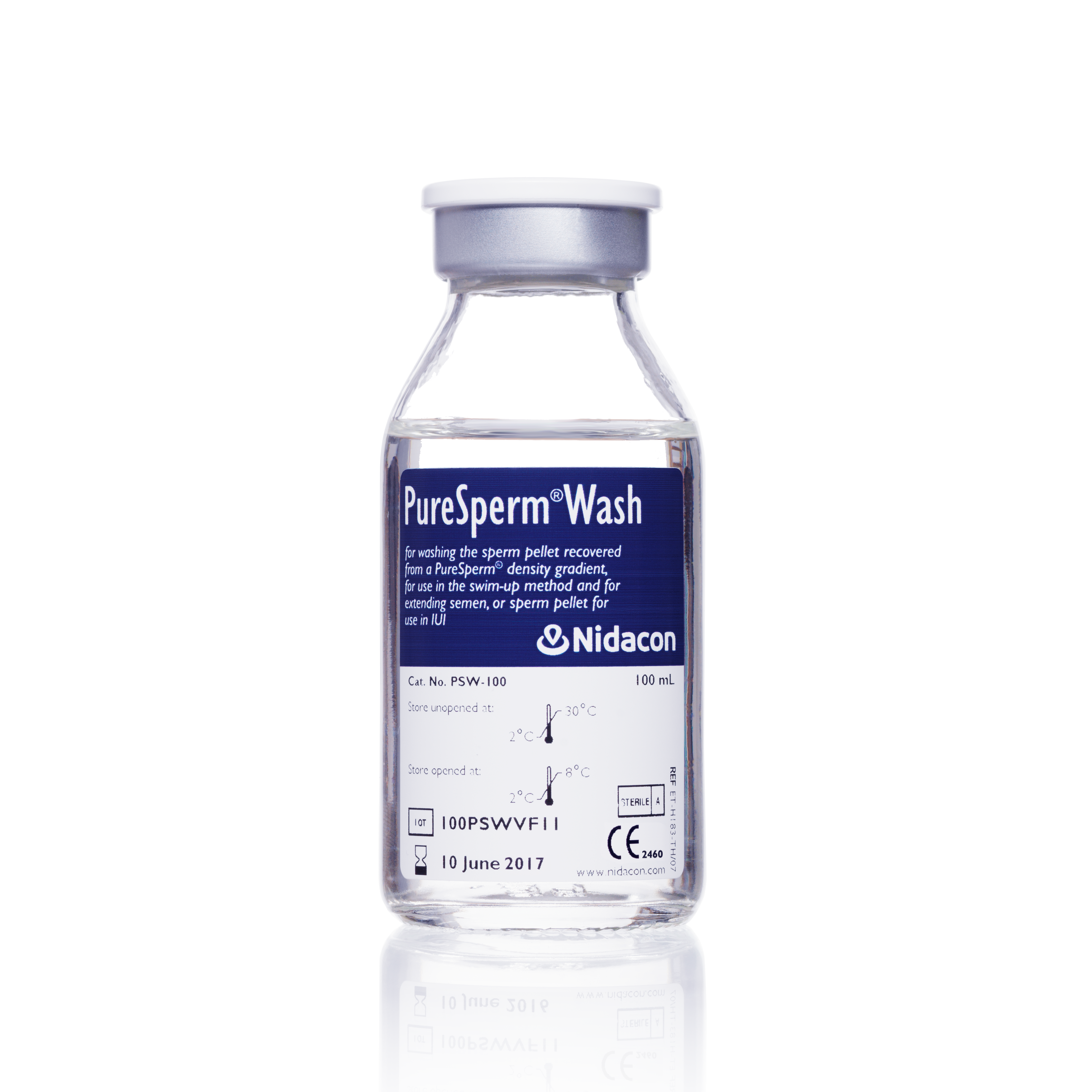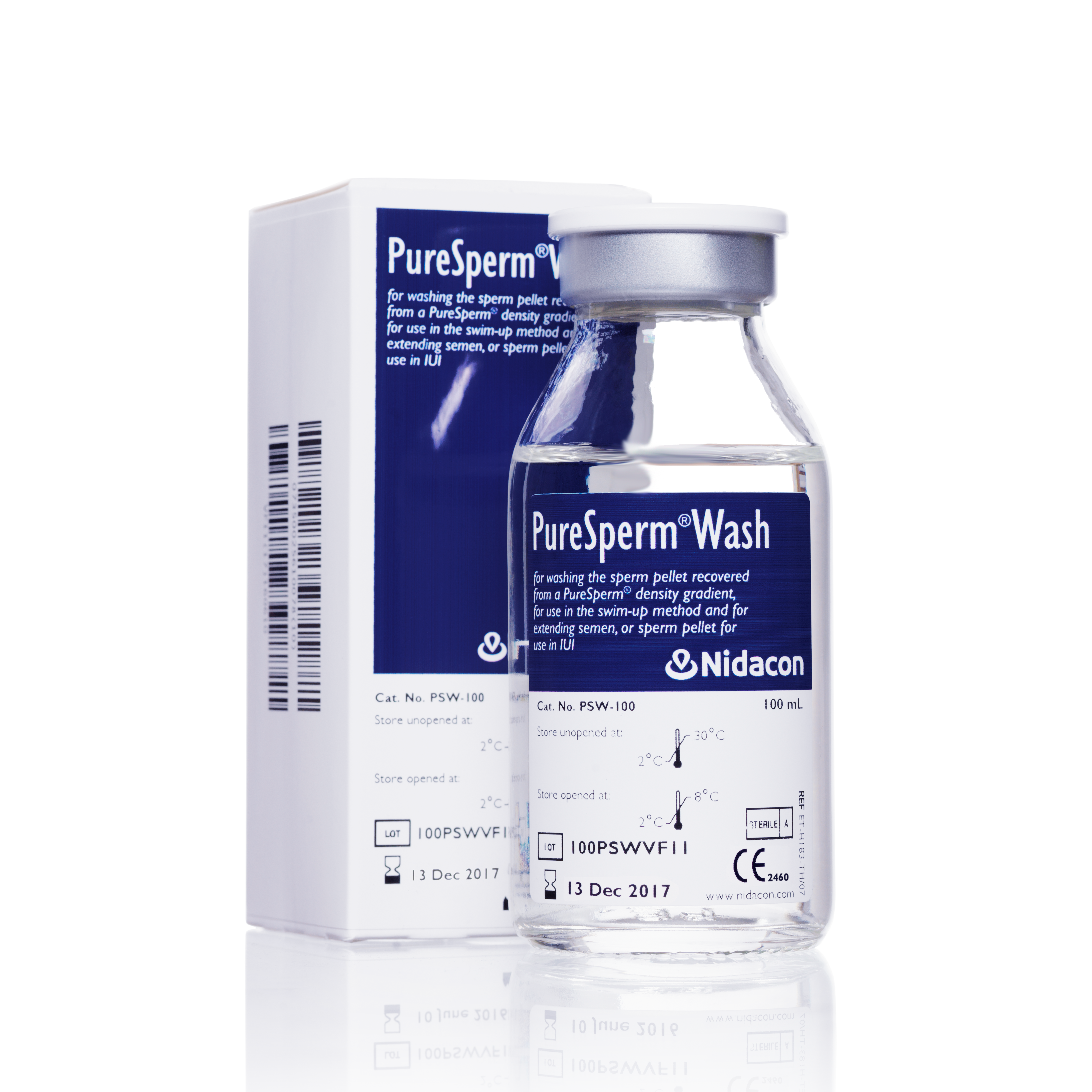PureSperm Wash – 100 mL
A three-in-one product.
PSW-100 100mL
PureSperm Wash has been optimised to serve various different purposes. This one product can be used for washing the sperm pellet recovered after density gradient preparation, for use in swim-up procedures, for extending the sperm prior to Intra Uterine Insemination (IUI), and as a maintenance medium.
Features
- Thanks to its stable formulation, PureSperm Wash has a shelf-life up to 1 year.
- PureSperm Wash does not contain any colouring agents or preservatives, both of which can be toxic to sperm.
- PureSperm Wash is a sterile isotonic salt solution.
Components
- Sodium chloride
- Potassium chloride
- Magnesium sulphate
- Potassium dihydrogen phosphate
- Sodium bicarbonate
- Purified water
- hSA (human Serum Albumin)
- Glucose
- Calcium lactate
- Sodium pyruvate
- EDTA
- HEPES
Performance Characteristics
- pH: 7.3-8.5.
- Osmolality (mOsm/kg H2O): 290-300.
- Endotoxin levels: <1.0 EU/mL.
- Sperm survival 18 hours after density gradient separation: >70%.
- Contents are tested by human sperm survival only.
- Bottles and stoppers are M.E.A. tested.
Storage and Stability
- Store unopened bottles between 2 and 30ºC. Avoid temperatures above or below these values. When stored under these conditions, Pure Sperm Wash has a shelf-life of 12 months from date of production. The expiry date is shown on both bottles and cartons.
- Open and close bottles under aseptic conditions. After opening, store between 2 and 8ºC when not in use.
- The shelf-life described on the product label is only applicable when the product is stored according to manufacturer’s recommendations.
- No antibiotics, unstable additives, or preservatives have been added to PureSperm Wash.
Precautions and warnings
- Use aseptic procedures at all times.
- If available, use sealed centrifuge buckets during centrifugation to avoid creation of aerosols.
- PureSperm Wash does not present a fire or combustion hazard. A material safety data sheet is available from the distributor or manufacturer.
- Do not use any solution which shows evidence of bacterial contamination.
- Do not use contents if tamper-evident seal is broken.
- Federal Law (USA) restricts this device to sale by or on the order of a physician.
- Please check for regulatory compliance governing the use of ART products in your country.
General recommendations
Documents
References
Evolution of the Effects of Different In Vitro Incubation Conditions on Sperm DNA Fragmentation
Forsell et al
Presented at Nordic Fertility Society meeting 2011 in Malmo, Sweden
Platelet-activating factor significantly enhances intrauterine insemination pregnancy rates in non-male factor infertility.
W. Roudebush, A. Toledo, H. Kort, D. Mitchell-Leef, C. Elsner, J. Massey
Fertility and Sterility, Volume 82, Issue 1, Pages 52-56
Effect of various commercial buffers on sperm viability and capacitation
Alessandra Andrisani1 , Gabriella Dona` 2 *, Guido Ambrosini1 , Guglielmo Bonanni3 , Marcantonio Bragadin4 , Erich Cosmi1 , Giulio Clari2 , Decio Armanini3 , and Luciana Bordin2
FAQ
When should PureSperm Wash be used?
We recommend PureSperm Wash for washing the sperm pellet after centrifugation using a PureSperm density gradient. The ionic balance of PureSperm Wash lies between that of the gradient and commonly used fertilisation media and, therefore, will not cause premature hyperactivation of the sperm. PureSperm Wash is also ready-to-use and contains an appropriate level of human serum albumin.
What are the constituents of PureSperm Wash?
PureSperm Wash is an isotonic (290-300 mOsm/kg H2O), HEPES-buffered salt solution containing glucose, EDTA, and human serum albumin.
Is there any protein in PureSperm Wash?
Yes. Research in our laboratory showed that human serum albumin must be added to the PureSperm Wash to prevent sperm sticking to plastic-ware and microscope slides.
Are antibiotics included in PureSperm Wash?
No, PureSperm Wash does not contain antibiotics. First of all, antibiotics commonly used in cell culture media are toxic to sperm and the gradient will remove most, if not all, of the bacterial contamination present in the ejaculate, provided that the retrieval of the sperm pellet is carried out according to the instructions given in the package insert.
Should PureSperm Wash be refrigerated?
PureSperm Wash is supplied as a sterile solution which does not need refrigerated storage in the unopened bottle. After opening (under sterile conditions), however, PureSperm Wash should be kept at 2-8°C.
Do I need to add protein or other additives to PureSperm Wash?
No, PureSperm Wash is a complete, ready-to-use product. It contains human serum albumin as an excipient, and this albumin is carefully selected for safety. For further information on safety, please see product insert. The only additive that we recommend is penicillin when performing a swim-up.
Should I equilibrate PureSperm Wash in the CO2 incubator before use?
No, it’s not necessary to equilibrate PureSperm Wash in the CO2 incubator before use. However, if the bottle has been opened previously and then stored in the refrigerator, the PureSperm Wash should be brought to room temperature before use to avoid cold shocking the sperm.
If there are no antibiotics or preservatives present, how can PureSperm Wash have a shelf life of one year?
PureSperm Wash has been formulated with a stable mixture of salts and human serum albumin. The product is filled aseptically, and each batch undergoes stringent quality assurance tests for sterility and low endotoxin levels. The product has been rigorously tested to ensure its good performance is retained throughout the shelf life.
How can a washing solution optimize the sperm preparation results?
When comparing PureSperm Wash (PSW) to other washing buffers, it has been shown that PSW
• maintains the correct ROS production better (1)
• achieves the highest percentage of capacitated sperm (1).
• produces higher sperm counts (2)
This suggests that PSW may be better at maintaining and supporting the sperm.
References:
1. Effects of various commercial buffers on sperm viability and capacitation
Andrisani et al, Systems Biology in Reproductive Medicine 2014
2.Effects of lubricants and wash solutions on semen evaluation in a fertility clinics laboratory
Abadie et al, Lab medicine spring 2014


